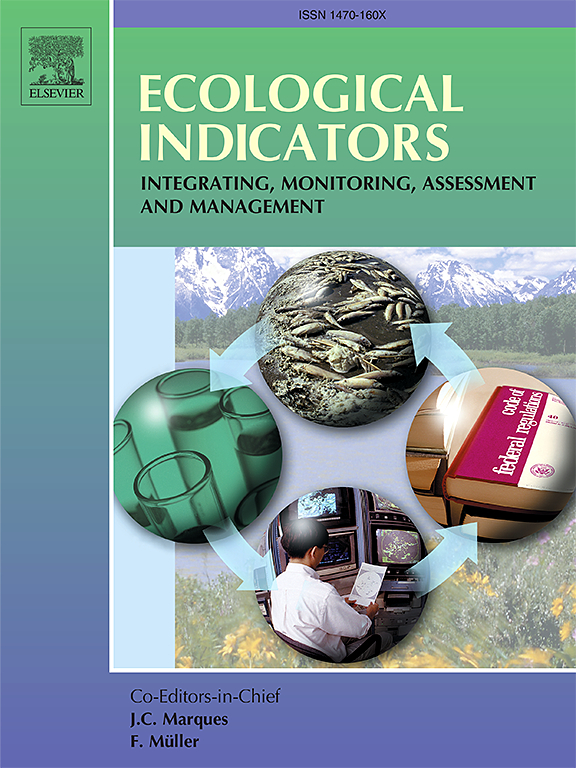武汉市可持续发展的水-碳-经济耦合系统动力学与投资模型
IF 7
2区 环境科学与生态学
Q1 ENVIRONMENTAL SCIENCES
引用次数: 0
摘要
理解水安全、碳储存和经济社会发展之间的相互作用对于实现可持续城市化至关重要。通过系统动力学(SD)和生态系统服务与权衡综合评价(InVEST)模型的结合,建立了武汉市生态环境价值耦合系统模型,量化了武汉市生态系统的动态社会经济过程和空间生态格局。采用力学模型量化系统协调性,评价城市可持续性。模拟未来情景以确定最佳发展路径。结果表明:①2000-2020年,绿色经济社会发展使资源利用效率提高了+289%,但使生态安全水平降低了- 41%;(2) WCE系统协调性提高(0.45→0.68),主要约束条件由水资源短缺转向碳储量亏缺。(3)未来情景模拟(2021-2030年)表明,基线情景下的协调性下降,而低碳绿色战略的协调性达到最优(>0.8),显著优于生态保护和高强度城市化战略。本研究首次对长江流域特大城市WCE相互作用和协调状况进行了定量评估,证明了SD-InVEST耦合在整合社会经济动态与生态系统空间过程方面的优势。拟议的框架为综合城市规划提供了一个科学的工具,将水-碳-经济联系起来,并将低碳绿色路径确定为提高可持续性的关键。本文章由计算机程序翻译,如有差异,请以英文原文为准。

A water-carbon-economic model coupling system dynamics and InVEST for Wuhan’s sustainability assessment
Understanding the interactions between water security, carbon storage, and economic and social development (WCE) is critical for achieving sustainable urbanization. This study establishes a coupled WCE system model for Wuhan, China, by integrating System Dynamics (SD) and the Integrated Valuation of Ecosystem Services and Tradeoffs (InVEST) model to quantify dynamic socioeconomic processes and spatial ecological patterns. A mechanical model was further employed to quantify system coordination and assess urban sustainability. Future scenarios were simulated to identify optimal development pathways. The results showed: (1) During the historical period (2000–2020), green economic and social development enhanced resource utilization efficiency (+289%) but reduced ecological security levels (−41%). (2) WCE system coordination improved (0.45 → 0.68), while the primary constraint shifted from water scarcity to carbon storage deficit. (3) Future scenario simulations (2021–2030) indicate declining coordination under baseline scenario, whereas the low-carbon green strategy achieves optimal coordination (>0.8), significantly outperforming ecological protection and high-intensity urbanization strategies. This work provides the first quantitative assessment of WCE interactions and coordination status in megalopolises along the Yangtze River Basin, demonstrating the advantage of SD-InVEST coupling in integrating socioeconomic dynamics with ecosystem spatial processes. The proposed framework offers a scientific tool for comprehensive urban planning incorporating water-carbon-economy nexus, with the low-carbon green pathway identified as essential for enhancing sustainability.
求助全文
通过发布文献求助,成功后即可免费获取论文全文。
去求助
来源期刊

Ecological Indicators
环境科学-环境科学
CiteScore
11.80
自引率
8.70%
发文量
1163
审稿时长
78 days
期刊介绍:
The ultimate aim of Ecological Indicators is to integrate the monitoring and assessment of ecological and environmental indicators with management practices. The journal provides a forum for the discussion of the applied scientific development and review of traditional indicator approaches as well as for theoretical, modelling and quantitative applications such as index development. Research into the following areas will be published.
• All aspects of ecological and environmental indicators and indices.
• New indicators, and new approaches and methods for indicator development, testing and use.
• Development and modelling of indices, e.g. application of indicator suites across multiple scales and resources.
• Analysis and research of resource, system- and scale-specific indicators.
• Methods for integration of social and other valuation metrics for the production of scientifically rigorous and politically-relevant assessments using indicator-based monitoring and assessment programs.
• How research indicators can be transformed into direct application for management purposes.
• Broader assessment objectives and methods, e.g. biodiversity, biological integrity, and sustainability, through the use of indicators.
• Resource-specific indicators such as landscape, agroecosystems, forests, wetlands, etc.
 求助内容:
求助内容: 应助结果提醒方式:
应助结果提醒方式:


